The Coupling Effect of Organosilicon Hydrophobic Agent and Cement on the Water Resistance of Phosphogypsum
Abstract
:1. Introduction
2. Methodology
2.1. Raw Materials
2.2. Mixing Proportion
2.3. Test Methods
2.3.1. Water-Resistance
2.3.2. Microstructure
3. Results and Discussion
3.1. Influence of the Hydrophobic Agent Content on the Properties of Phosphogypsum
3.1.1. Fluidity and Setting Time
3.1.2. Hydrophobic Agent Water-Resistance and Mechanical Properties
3.2. The Influence of Cement Content on the Physical and Mechanical Properties
3.2.1. Fluidity and Setting Time
3.2.2. Water Resistance and Mechanical Properties of Hydrophobic Agents
3.3. The Influence of Cement and Hydrophobic Agents on the Surface Contact Angle of Phosphogypsum
3.4. Influence Mechanism of Hydrophobic Agent and Cement
3.4.1. Hydration Products of Phosphogypsum
3.4.2. Hydrophobic Agent Micromorphology of the Hydration Product
4. Conclusions
- (1)
- With the increase of the silicone hydrophobic agent dosage from 0.1 wt.% to 0.5 wt.%, the water absorption of the hardened phosphogypsum was decreased from 18.0% to 0.9%. The softening coefficient was improved to 0.99 when the dosage was 0.5 wt.%. Meanwhile, the compressive strength and flexural strength of phosphogypsum decreased first at 0.1 wt.% and then increased as the amount of added hydrophobic agent increased.
- (2)
- In the case of 0.3% content of the silicone hydrophobic agent, with the increase in the weight ratios of cement, the softening coefficient of the phosphogypsum was increased from 0.80 to 0.99. The water absorption of the phosphogypsum decreased to 0.8%, with a weight ratio of cement which was 0.6 wt.%. The contact angle of phosphogypsum increased from 47.56° to 147.23° under the coupling effect of hydrophobic agents and cement. However, the compressive and flexural strength of phosphogypsum reduced consistently with the increase of the weight ratios of cement.
- (3)
- When the cement was added together with the hydrophobic agent, appropriate alkalinity promoted the hydrolysis of the hydrophobic agent, which was conducive to the polymerization of the hydrophobic organic on the surface of the gypsum crystal. When the 0.3 wt.% of cement was used to adjust alkalinity, gypsum crystal coarsening occurred in the silicone hydrophobic agent–gypsum system. The coarsening of the crystals led to a strength decrease in phosphogypsum. Thus, the coupling of the organosilicon hydrophobic agent and cement exhibited higher mechanical and water-resistance properties than separate organosilicon addition.
Author Contributions
Funding
Institutional Review Board Statement
Informed Consent Statement
Data Availability Statement
Acknowledgments
Conflicts of Interest
References
- Gijbels, K.; Iacobescu, R.I.; Pontikes, Y.; Schreurs, S.; Schroeyers, W. Alkali-activated binders based on ground granulated blast furnace slag and phosphogypsum. Constr. Build. Mater. 2019, 215, 371–380. [Google Scholar] [CrossRef]
- Rashad, A.M. Phosphogypsum as a construction material. J. Clean. Prod. 2017, 166, 732–743. [Google Scholar] [CrossRef]
- Wang, Q.; Cui, Y.; Xue, J. Study on the improvement of the hydrophobic and mechanical properties of hemihydrate phosphogypsum based foam insulation materials. Constr. Build. Mater. 2020, 230, 117014. [Google Scholar] [CrossRef]
- Ma, B.; Jin, Z.; Su, Y.; Lu, W.; Qi, H.; Hu, P. Utilization of hemihydrate phosphogypsum for the preparation of porous sound absorbing material. Constr. Build. Mater. 2020, 234, 117346. [Google Scholar] [CrossRef]
- Jin, Z.; Ma, B.; Su, Y.; Lu, W.; Qi, H.; Hu, P. Effect of calcium sulphoaluminate cement on mechanical strength and hydrophobic properties of beta-hemihydrate phosphogypsum. Constr. Build. Mater. 2020, 242, 118198. [Google Scholar] [CrossRef]
- Zhu, C.; Zhang, J.; Peng, J.; Cao, W.; Liu, J. Physical and mechanical properties of gypsum-based composites reinforced with PVA and PP fibers. Constr. Build. Mater. 2018, 163, 695–705. [Google Scholar] [CrossRef]
- Sun, D.; Wang, L. Utilization of paraffin/expanded perlite materials to improve mechanical and thermal properties of cement mortar. Constr. Build. Mater. 2015, 101, 791–796. [Google Scholar] [CrossRef]
- An, Z.-Z.; Zhou, Z.-Y.; Xia, Y.-M.; Xin, D.; Hu, X.-Y.; Fang, Y. Modulating water absorption of hardened gypsum plaster with enhanced mechanical strengths by molecular modification of polyvinyl alcohol. J. Mater. Civ. Eng. 2019, 31, 06019014. [Google Scholar] [CrossRef]
- Hu, Y.Y.; He, T.S.; Song, X.F. Influence of modified organosilicon hydrophobic agent on durability of concrete. Adv. Mater. Res. 2015, 1094, 269–272. [Google Scholar] [CrossRef]
- Deng, Y.; Xuan, L.; Feng, Q. Effect of a hydrophobic agent on gypsum particleboard properties. Wood Res. Technol. Holzforschung. 2006, 60, 318–321. [Google Scholar] [CrossRef]
- GB/T 23451-2009; Light Weight Panel for Partition Wall Used in Buildings; Administration of Quality Supervision, Inspection and Quarantine of the People’s Republic of China and Standardization Administration of the People’s Republic China: Beijing, China, 2009.
- JCJ 70-2009; Basic Performance test Method for building Mortar, China; Ministry of Construction of the People’s Republic of China: Beijing, China, 2009.
- GB/T17671-1999; Cement Mortar Strength Test Method (ISO method), China; Administration of Quality Supervision Inspection and Quarantine of the People’s Republic of China and Standardization Administration of the People’s Republic China: Beijing, China, 1999.
- GB/T30447-2013; Measurement method for contact angle of nano-film surface, China; Administration of Quality Supervision Inspection and Quarantine of the People’s Republic of China and Standardization Administration of the People’s Republic China: Beijing, China, 2013.
- Wang, Q.; Zhuang, S.; Jia, R. An investigation on the anti-water properties of phosphorus building gypsum (PBG)-based mortar. J. Therm. Anal. 2019, 136, 1575–1585. [Google Scholar] [CrossRef]
- Su, J.F.; Wang, S.B. Fabrication and properties of microencapsulated-paraffin/gypsum-matrix building materials for thermal energy storage. Adv. Mater. Res. 2012, 427, 45–50. [Google Scholar] [CrossRef]
- Li, J.; Li, G.; Yu, Y. The influences of gypsum water-proofing additive on gypsum crystal growth. Mater. Lett. 2007, 61, 872–876. [Google Scholar] [CrossRef]
- Li, G.Z.; Li, J.Q.; Guan, R.F.; Sui, S.; Liu, H.S. Investigation of the water resistance of gypsum materials. ZKG Int. 2003, 56, 87–93. [Google Scholar]
- Zhang, Y.; Li, S.; Zhang, W.; Chen, X.; Hou, D.; Zhao, T.; Li, X. Preparation and mechanism of graphene oxide/isobutyltriethoxysilane composite emulsion and its effects on hydrophobic performance of concrete. Constr. Build. Mater. 2019, 208, 343–349. [Google Scholar] [CrossRef]
- Chen, B.; Shao, H.; Li, B.; Li, Z. Influence of silane on hydration characteristics and mechanical properties of cement paste. Cem. Concr. Compos. 2020, 113, 103743. [Google Scholar] [CrossRef]
- Grabowsky, S.; Beckmann, J.; Luger, P. The nature of hydrogen bonding involving the siloxane group. Aust. J. Chem. 2012, 65, 785–795. [Google Scholar] [CrossRef]
- Chen, X.; Wang, Q.; Wu, Q.; Xie, X.; Tang, S.; Yang, G.; Luo, L.; Yuan, H. Hydration reaction and microstructural characteristics of hemihydrate phosphogypsum with variable pH. Constr. Build. Mater. 2020, 316, 125891. [Google Scholar] [CrossRef]


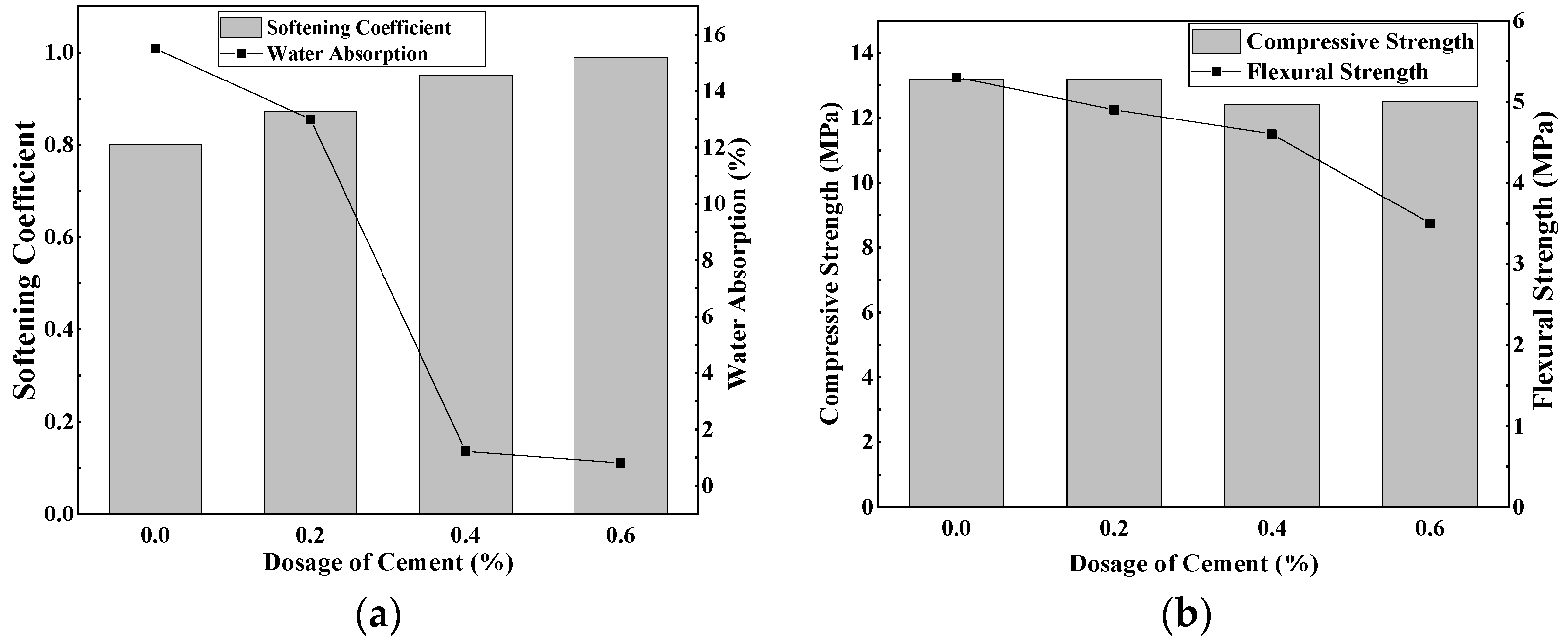
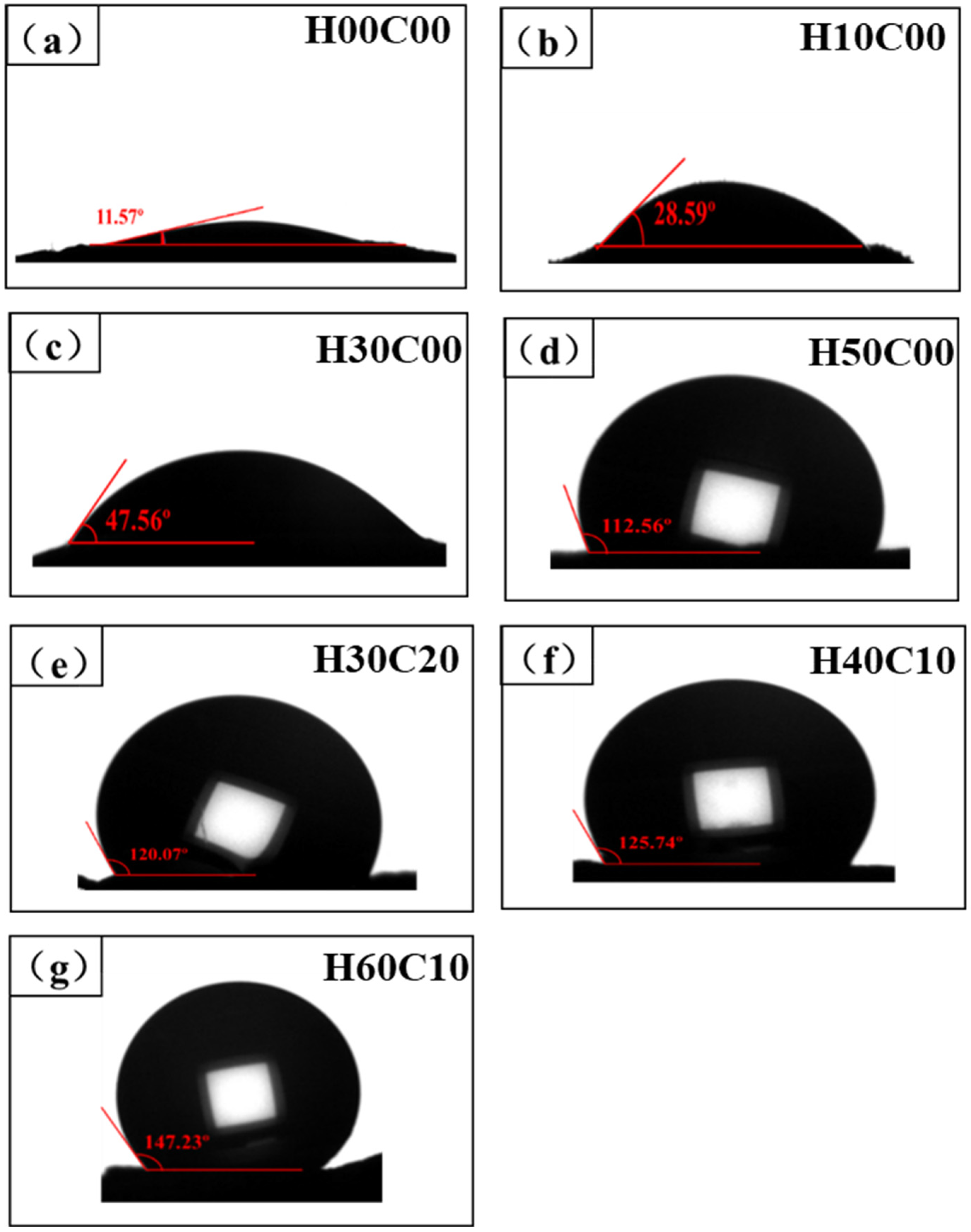
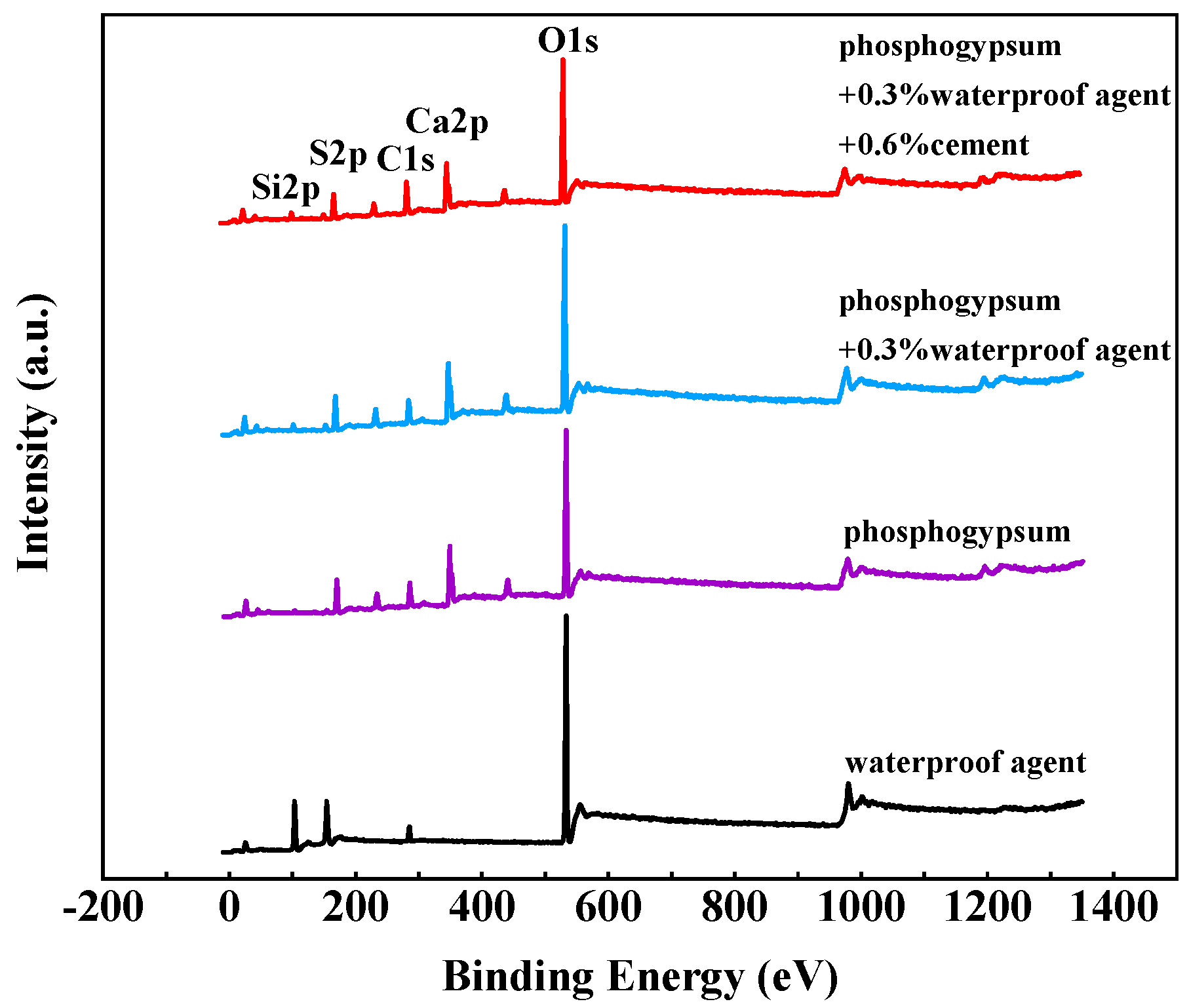
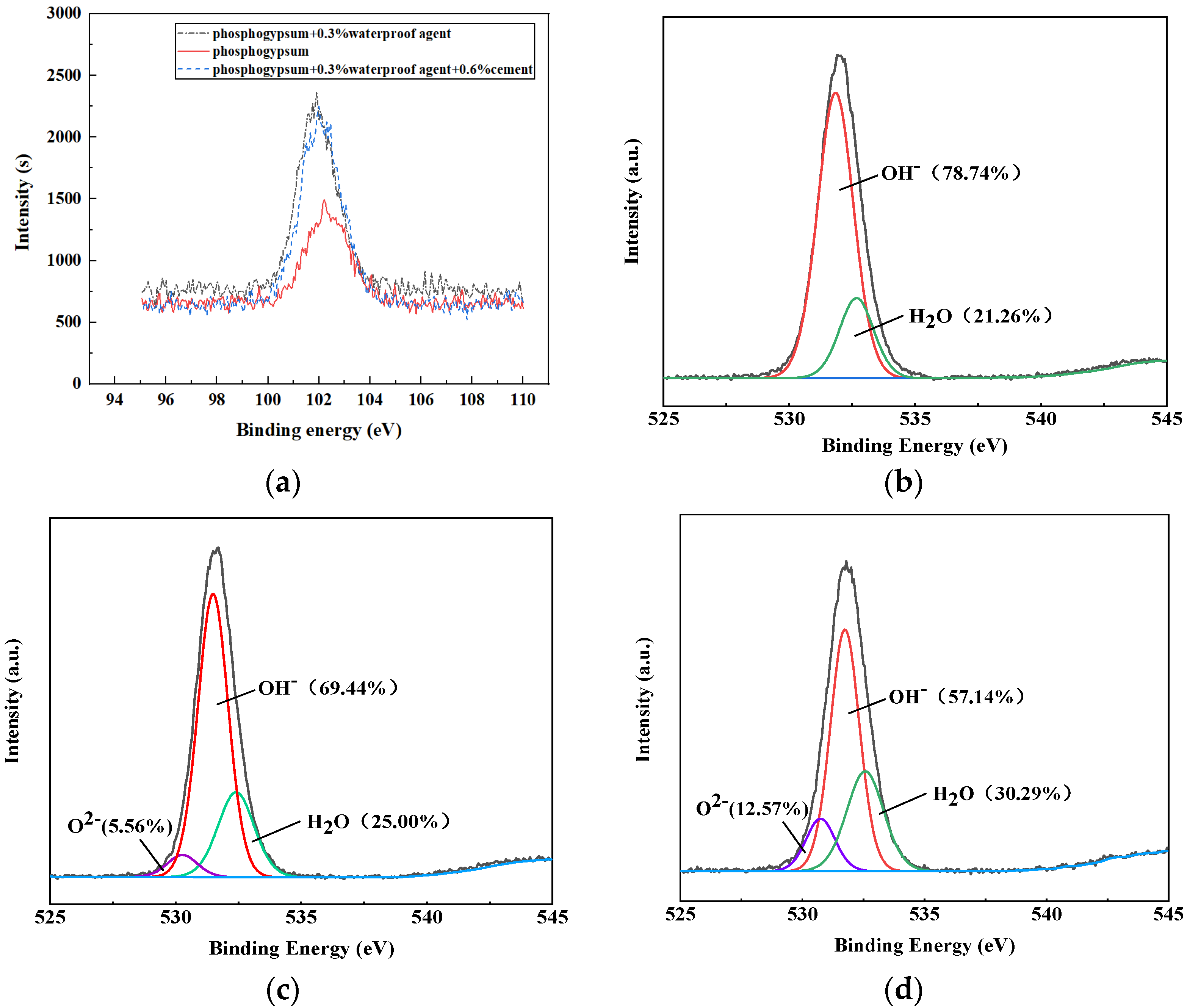
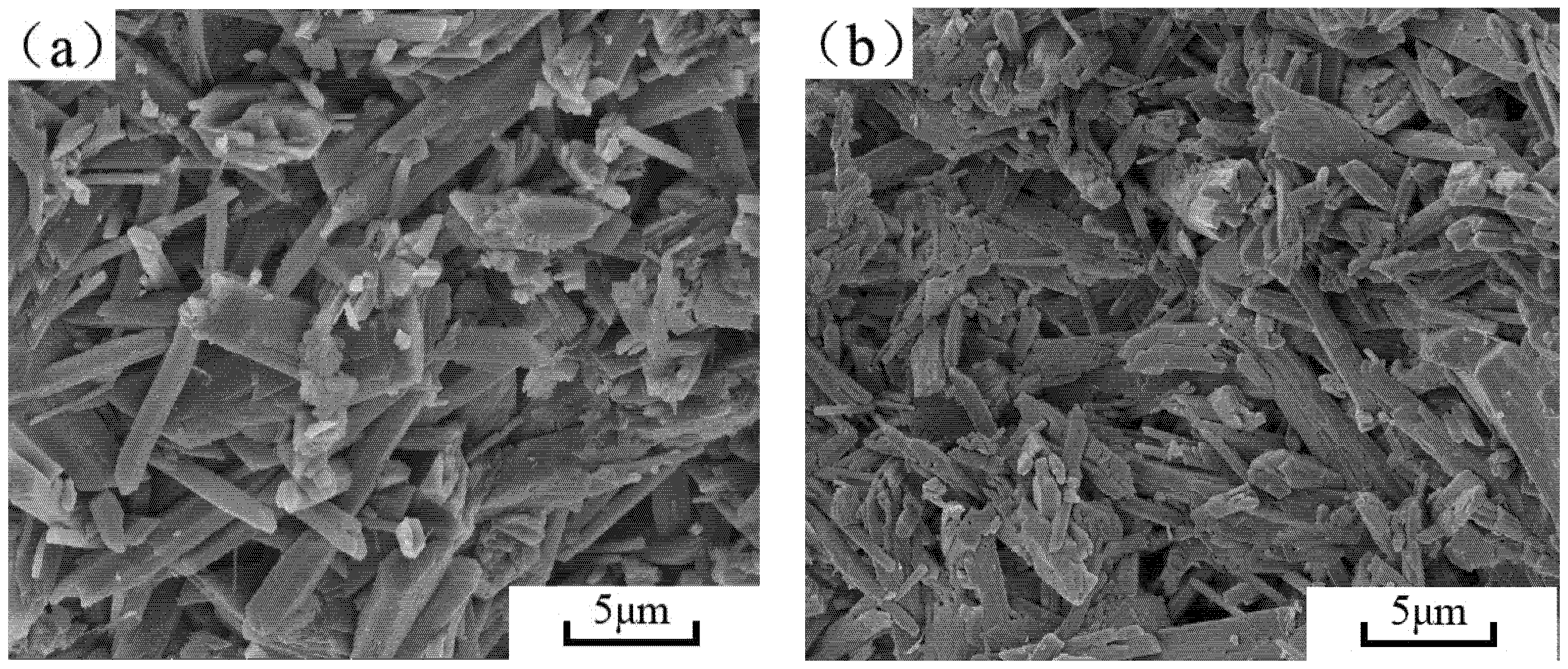
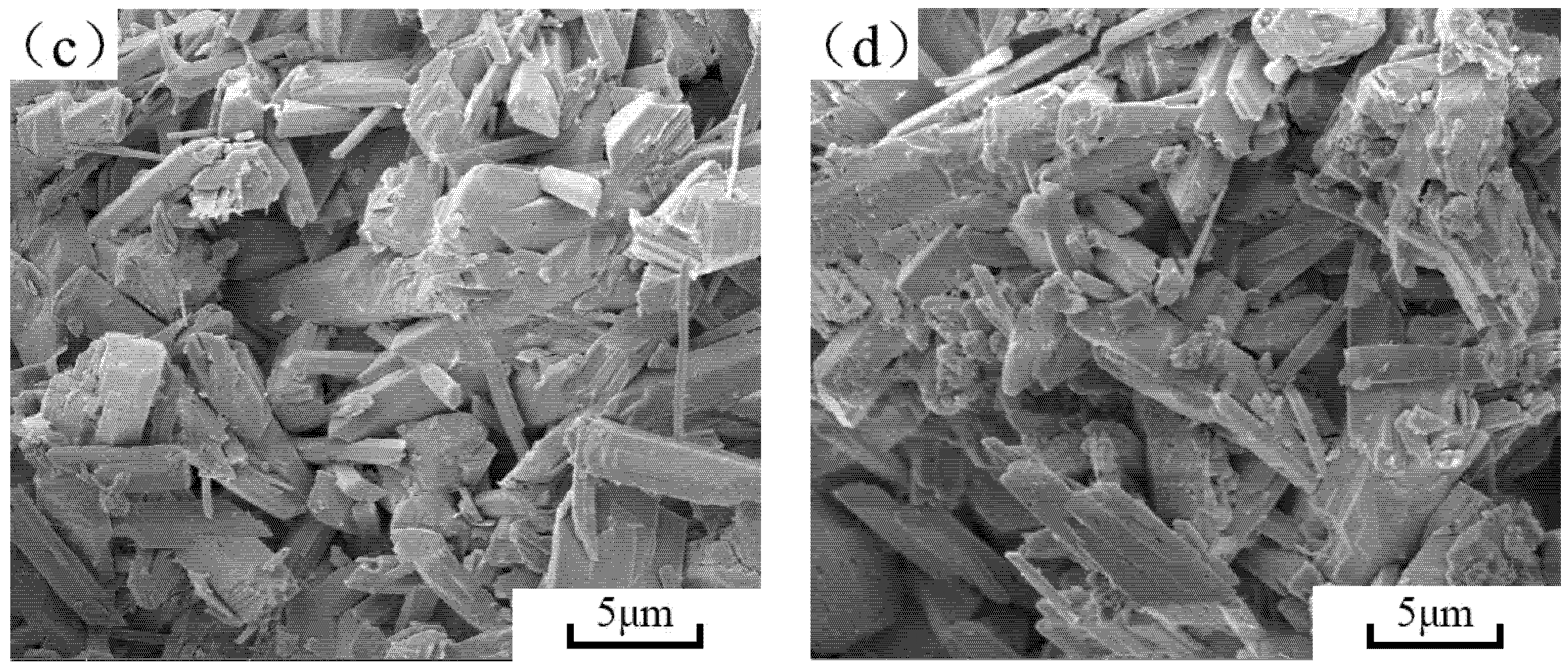
| Oxide | SiO2 | MgO | Al2O3 | Fe2O3 | CaO | K2O | SO3 | TiO2 | P2O5 | Loss |
|---|---|---|---|---|---|---|---|---|---|---|
| Phosphogypsum | 4.62 | 0.18 | 2.90 | 1.13 | 42.67 | 0.25 | 43.04 | 0.21 | 2.11 | 2.89 |
| Cement | 21.39 | 2.82 | 5.15 | 3.86 | 61.04 | 0.62 | 3.10 | 0.85 | 0.10 | 1.07 |
| Number | Water-Binder Ratio | Phosphogypsum/% | Cement/% | Hydrophobic Agent/% | Retarder/% | Water Reducing Agent/% |
|---|---|---|---|---|---|---|
| H00C00 | 0.4 | 100.0 | 0.0 | 0.0 | 0.1 | 0.7 |
| H10C00 | 0.4 | 100.0 | 0.0 | 0.1 | 0.1 | 0.7 |
| H30C00 | 0.4 | 100.0 | 0.0 | 0.3 | 0.1 | 0.7 |
| H50C00 | 0.4 | 100.0 | 0.0 | 0.5 | 0.1 | 0.7 |
| H30C20 | 0.4 | 99.8 | 0.2 | 0.3 | 0.1 | 0.7 |
| H30C40 | 0.4 | 99.6 | 0.4 | 0.3 | 0.1 | 0.7 |
| H30C60 | 0.4 | 99.4 | 0.6 | 0.3 | 0.1 | 0.7 |
| Number | Hydrophobic Agent/wt.% | Liquidity/mm | Initial Set/min | Final Set/min |
|---|---|---|---|---|
| H00C00 | 0 | 220 | 45 | 61 |
| H10C00 | 0.1 | 225 | 47 | 64 |
| H30C00 | 0.3 | 228 | 49 | 65 |
| H50C00 | 0.5 | 230 | 50 | 65 |
| Number | Cement Content/wt.% | Liquidity/mm | Initial Set/min | Final Set/min |
|---|---|---|---|---|
| H30C20 | 0.2 | 230 | 52 | 67 |
| H30C40 | 0.4 | 233 | 53 | 69 |
| H30C60 | 0.6 | 235 | 55 | 70 |
| Samples | Ca 2p/% | C 1s/%/% | O 1s/%/% | Si 2p/% | S 2p/% |
|---|---|---|---|---|---|
| Hydrophobicing agent | 0.00 | 9.57 | 56.52 | 33.91 | 0.00 |
| phosphogypsum | 10.65 | 20.89 | 50.74 | 3.57 | 14.15 |
| Phosphogypsum +0.3 wt.% hydrophobic agent | 9.99 | 21.24 | 51.28 | 4.85 | 12.44 |
| Phosphogypsum +0.3 wt.% Hydrophobic agent +0.6 wt.% cement | 8.78 | 29.53 | 45.39 | 5.92 | 10.38 |
Publisher’s Note: MDPI stays neutral with regard to jurisdictional claims in published maps and institutional affiliations. |
© 2022 by the authors. Licensee MDPI, Basel, Switzerland. This article is an open access article distributed under the terms and conditions of the Creative Commons Attribution (CC BY) license (https://creativecommons.org/licenses/by/4.0/).
Share and Cite
Ma, P.; Wang, C.; Gao, Y.; Gu, X.; Cheng, B.; Fang, Z.; Xiong, G.; Wu, J. The Coupling Effect of Organosilicon Hydrophobic Agent and Cement on the Water Resistance of Phosphogypsum. Materials 2022, 15, 845. https://doi.org/10.3390/ma15030845
Ma P, Wang C, Gao Y, Gu X, Cheng B, Fang Z, Xiong G, Wu J. The Coupling Effect of Organosilicon Hydrophobic Agent and Cement on the Water Resistance of Phosphogypsum. Materials. 2022; 15(3):845. https://doi.org/10.3390/ma15030845
Chicago/Turabian StyleMa, Pengfei, Chong Wang, Yuxin Gao, Xiaowei Gu, Baojun Cheng, Zheng Fang, Guangqi Xiong, and Jing Wu. 2022. "The Coupling Effect of Organosilicon Hydrophobic Agent and Cement on the Water Resistance of Phosphogypsum" Materials 15, no. 3: 845. https://doi.org/10.3390/ma15030845





